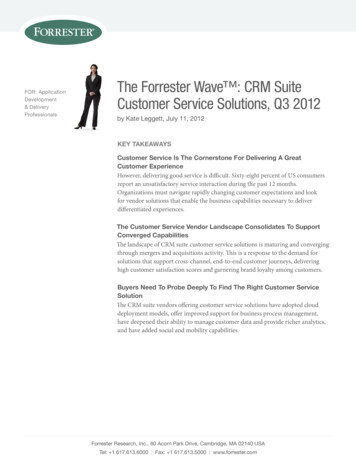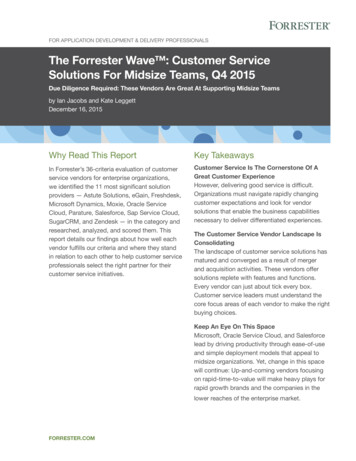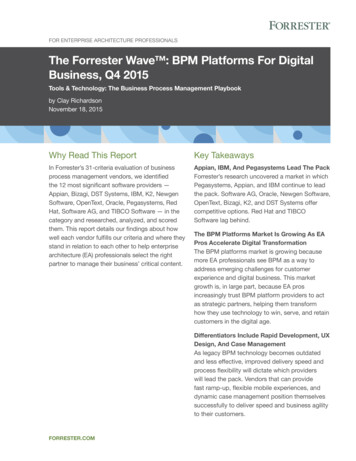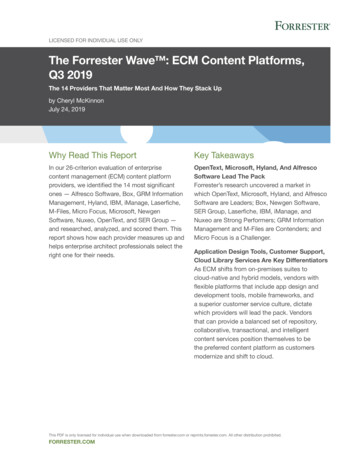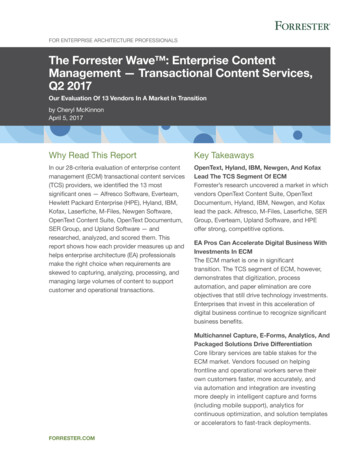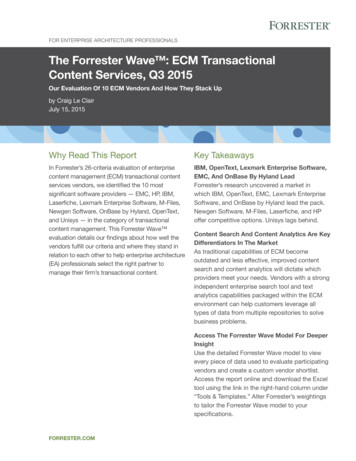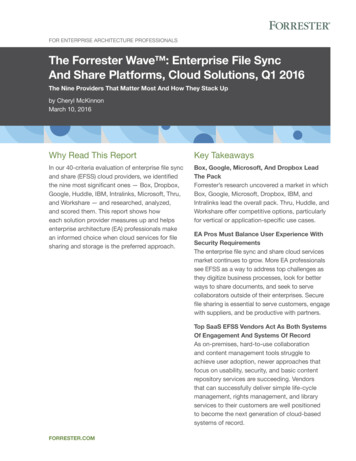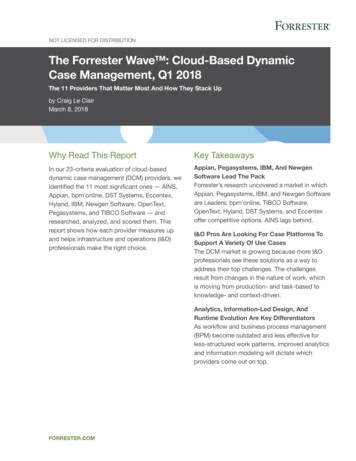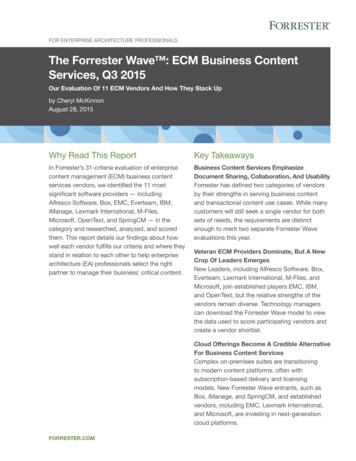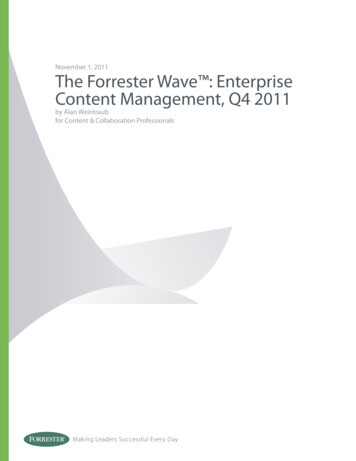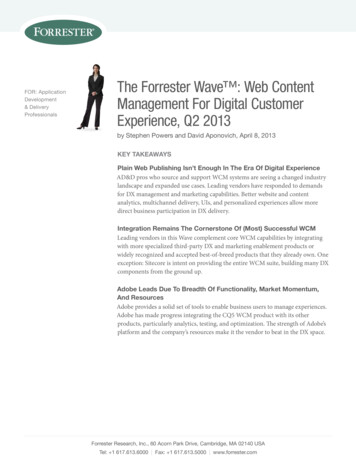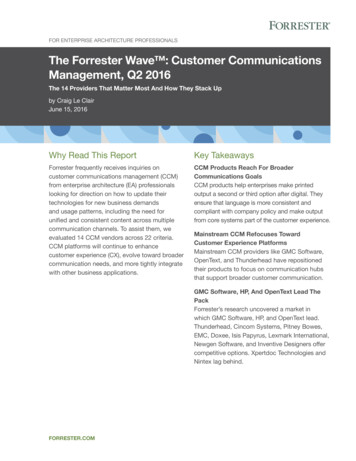
Transcription
For Enterprise Architecture ProfessionalsThe Forrester Wave : Customer CommunicationsManagement, Q2 2016The 14 Providers That Matter Most And How They Stack Upby Craig Le ClairJune 15, 2016Why Read This ReportKey TakeawaysForrester frequently receives inquiries oncustomer communications management (CCM)from enterprise architecture (EA) professionalslooking for direction on how to update theirtechnologies for new business demandsand usage patterns, including the need forunified and consistent content across multiplecommunication channels. To assist them, weevaluated 14 CCM vendors across 22 criteria.CCM platforms will continue to enhancecustomer experience (CX), evolve toward broadercommunication needs, and more tightly integratewith other business applications.CCM Products Reach For BroaderCommunications GoalsCCM products help enterprises make printedoutput a second or third option after digital. Theyensure that language is more consistent andcompliant with company policy and make outputfrom core systems part of the customer experience.Mainstream CCM Refocuses TowardCustomer Experience PlatformsMainstream CCM providers like GMC Software,OpenText, and Thunderhead have repositionedtheir products to focus on communication hubsthat support broader customer communication.GMC Software, HP, And OpenText Lead ThePackForrester’s research uncovered a market inwhich GMC Software, HP, and OpenText lead.Thunderhead, Cincom Systems, Pitney Bowes,EMC, Doxee, Isis Papyrus, Lexmark International,Newgen Software, and Inventive Designers offercompetitive options. Xpertdoc Technologies andNintex lag behind.forrester.com
For Enterprise Architecture ProfessionalsThe Forrester Wave : Customer Communications Management,Q2 2016The 14 Providers That Matter Most And How They Stack Upby Craig Le Clairwith Alex Cullen, Shaun McGovern, and Diane LynchJune 15, 2016Table Of Contents2 Why Customer CommunicationsManagement MattersCCM Providers Evolve To A StrongerCustomer Experience LinkageTechnical Environments Are Still AHodgepodge3 The CCM Market Extends Beyond The 14Evaluated VendorsNiche Providers Focus On Specific UseCases And Industry Solutions4 CCM Evaluation OverviewEvaluated Vendors And Inclusion Criteria8 Vendor ProfilesLeaders With Well-Balanced CapabilitiesDrive The MarketNotes & ResourcesForrester conducted vendor evaluations in Marchand April 2016 with all 14 participating vendorsand surveyed dozens of customer references.Vendors include Cincom Systems, Doxee,EMC, GMC Software, HP, Inventive Designers,Isis Papyrus, Lexmark International, NewgenSoftware, Nintex, OpenText, Pitney Bowes,Thunderhead, and Xpertdoc Technologies.Related Research DocumentsBrief: Ten Trends Will Reshape CustomerCommunications ManagementCorrespondence Management — A ReclamationProject For Many But A Superfund Site For MostThe Forrester Wave : Document Output ForCustomer Communications Management, Q1 2014Strong Performers Offer ExtensiveCapabilities With A Bit More FocusContenders Offer Price And ServiceAlternatives17 Supplemental MaterialForrester Research, Inc., 60 Acorn Park Drive, Cambridge, MA 02140 USA 1 617-613-6000 Fax: 1 617-613-5000 forrester.com 2016 Forrester Research, Inc. Opinions reflect judgment at the time and are subject to change. Forrester ,Technographics , Forrester Wave, RoleView, TechRadar, and Total Economic Impact are trademarks of ForresterResearch, Inc. All other trademarks are the property of their respective companies. Unauthorized copying ordistributing is a violation of copyright law. Citations@forrester.com or 1 866-367-7378
For Enterprise Architecture ProfessionalsJune 15, 2016The Forrester Wave : Customer Communications Management, Q2 2016The 14 Providers That Matter Most And How They Stack UpWhy Customer Communications Management MattersCustomer communications management software supports business requirements involvingletterheads, invoices, correspondence, and marketing materials as well as structured output suchas policies, statements, and welcome kits.1 CCM doesn’t get a lot of attention as a software market;it developed thirty years ago to help enterprises drive high-speed transaction printing. CCM is stillstrongly associated with the print channel, but ironically, it now helps enterprises move away fromprinting through emerging mobile, analytics, or customer experience technology.Enterprise architecture professionals looking to help line-of-business (LOB) owners improve thecustomer experience now realize the potential of CCM. Simultaneously, the CCM vendor landscape isevolving to meet broader communications goals. Here are the most significant findings that define the2016 CCM provider landscape.CCM Providers Evolve To A Stronger Customer Experience LinkageFor years, CCM has related to managing service communication, delivering correspondence andrecurring statements from content stored in systems of record. Today, the ability to link CCM to allpoints in the customer journey is gaining ground, with stronger mobile support and integration withmarketing automation and digital experience delivery platforms.2 Marketing is now in the loop andstrives to blend all communications to meet customer experience goals. Forrester sees:›› Stronger personalization and control for the interactive component. Return on investmentimproves when a worker can retrieve a document, enter data, or make selections that personalizethe output.3 Driven by this market opportunity, providers have improved user interaction with thedocument system by delivering thin-client interaction solutions that prompt the output creator andthen, based on the responses, pull in the correct form, product information, marketing message, orcompliance language.›› An emerging requirement of synchronizing input and output. The point of service now requiresreal-time document generation. Customers may engage via social media, a self-service portal,an SMS message, email, or the call center. The customer may need a signable set of documents,and to address this need, providers use e-form or web-form enhancements to collect data fromcustomers and turn it into documents instantly.›› Products moving to a multichannel conversation platform. Originally, few vendors hadmultichannel review and editing capabilities for the document designer or interactive user, but CCMcapabilities have improved over the past few years. While page-centric starting points for designstill dominate, vendors are slowly creating the abstraction required for true multichannel design andfor output that allows customer conversations. 2016 Forrester Research, Inc. Unauthorized copying or distributing is a violation of copyright law.Citations@forrester.com or 1 866-367-73782
For Enterprise Architecture ProfessionalsJune 15, 2016The Forrester Wave : Customer Communications Management, Q2 2016The 14 Providers That Matter Most And How They Stack Up›› Increasing focus on statements that engage. Enterprises are seeing opportunities to providebetter customer experiences via statements, documents, emails, or web pages that have links,support drilldowns, and include data summary and charting and embedded video objects. Thisapproach motivates customers to engage with the content and accomplish simple tasks andencourages paper suppression.Technical Environments Are Still A HodgepodgeCCM products typically have a programmer-oriented console to develop data models and integrationpoints, a design area for less technical users for documents and templates, and a third environmentscripting the internal worker’s interaction with the document system. Products support these threeneeds with a mix of thin and thick clients. None of the solutions are as unified or intuitive as we wouldlike to see. But vendors are on a path to:›› Make templates obsolete. Enterprises just have too many templates.4 They clone them forconvenience, create output for new channels, or struggle to find previously built templates. Asa result, enterprises must update, version, and track thousands of templates and individualfragments — a painful process. Dynamically built, intelligent documents reduce templates. Theygive users choices to construct documents in real time from objects in the repository.›› Address document assemblers who don’t come from a print background. New CCM users areless likely to evolve from skills with page layout tools designed to create print output. Today, they’remore likely to have skills in web development or mobile apps and to understand containers versuspages. Overall, however, the field is behind in addressing this transition.›› Improve business-side control. Most 2016 products have confusing separation between technologymanagement-oriented document assemblers and business users. Most allow configuration orexposure of features based on an enterprise’s needs. However, none of the products have anextremely easy-to-use business-side graphical user interface (GUI) with the ability to create variables,write rules, and create new interactive experiences. Over time, we expect LOB staff members to takeon more design and update responsibility, but today, this is still tech management’s game.The CCM Market Extends Beyond The 14 Evaluated VendorsThere are several important vendor options, some evaluated in previous Forrester Waves, that we arenot evaluating now due to changing product or marketing strategy:›› Adobe has moved correspondence management to its marketing cloud. Adobe CCMcapabilities remain part of Adobe Experience Manager (AEM) Forms and hence provide a unifiedplatform to collect and build communication content. The vendor’s e-signature capability,Adobe Sign, works well but is a separate product offering. Adobe has shifted from customercommunications management as a standalone offering and so does not meet the inclusion criteriafor this Forrester Wave. 2016 Forrester Research, Inc. Unauthorized copying or distributing is a violation of copyright law.Citations@forrester.com or 1 866-367-73783
For Enterprise Architecture ProfessionalsJune 15, 2016The Forrester Wave : Customer Communications Management, Q2 2016The 14 Providers That Matter Most And How They Stack Up›› Fidelity Information Services (FIS) is focusing on its new parents’ BPO business. FIS waspurchased by SunGard, which has an extensive managed-service business in financial servicesthat complements FIS’s payment-processing breadth. FIS now focuses on internal CCMapplications as part of a business process outsourcing (BPO) engagement.5›› Oracle Documaker is retaining customers with insurance and compliance focus. Oracle hasbeen a strong player but has curtailed its investment in CCM, especially around interactive CCM.Niche Providers Focus On Specific Use Cases And Industry SolutionsSeveral viable alternative providers do not appear in our primary research as they have regional focus,are relatively new entrants, or have narrower approaches to customer communications. These include:›› European providers with a strong EMEA focus. Europe, the Middle East, and Africa (EMEA)continue to be fertile ground for CCM innovation. Vendors include Assentis Technologies inSwitzerland for finance and telecommunications; Business Document (Bdoc) in France; IconSystemhaus in Germany for banking; and Intense Technologies in India.›› Established vendors taking new directions. Interactive CCM specialist Top Down Systems, wellknown for its Client Letter platform, will debut Intouch, a completely new cloud-based approachto CCM for sharing data, content, and processes across organizations. Ecrion, best known for theXML Rendering and applying business intelligence to statement data; Elixir, with a strong focus onthe Middle East; and GhostDraft, with roots in viewer technology, did not meet all inclusion criteria.›› Newer entrants choosing alternate CCM paths but lacking complete product offerings.Messagepoint by Prinova provides a cloud-based business-user content management platformwith connectors to GMC Software, HP Exstream, and others. Crawford Technologies continues toexcel with partnerships in CCM and the enterprise content management (ECM) community to plugdocument automation gaps for CCM use cases.CCM Evaluation OverviewTo assess the state of the customer communications market and see how the vendors stack upagainst each other, Forrester evaluated the strengths and weaknesses of top CCM vendors. Afterexamining past research, user need assessments, and vendor and expert interviews, we developed acomprehensive set of evaluation criteria. We evaluated vendors against 22 criteria, which we groupedinto three high-level buckets:›› Current offering. Forrester reviewed functionality across structured, interactive, and on-demandsegments for authoring, post composition, output management support, production and contentmanagement, integration, and application development environment.›› Strategy. We reviewed the vendors’ planned enhancements across the output segments andexamined partnership approaches, corporate strategy, target markets, and costs. 2016 Forrester Research, Inc. Unauthorized copying or distributing is a violation of copyright law.Citations@forrester.com or 1 866-367-73784
For Enterprise Architecture ProfessionalsJune 15, 2016The Forrester Wave : Customer Communications Management, Q2 2016The 14 Providers That Matter Most And How They Stack Up›› Market presence. We looked at installed base, revenue growth, services, number of employees,and technology partners. We estimated numbers when vendors declined to disclose actual figures.Evaluated Vendors And Inclusion CriteriaThe CCM product landscape includes enterprise-level, full-corporate solutions that can potentiallysupport the unique requirements of all three CCM segments: interactive, on-demand, and structuredoutput. Other vendors provide strong support for one or two of the three segments (see Figure 1).Forrester included 14 vendors in the assessment: Cincom Systems, Doxee, EMC, GMC Software, HP,Inventive Designers, Isis Papyrus, Lexmark International, Newgen Software, Nintex, OpenText, PitneyBowes, Thunderhead, and Xpertdoc Technologies (see Figure 2).For inclusion in this evaluation, enterprise CCM software solution vendors must:›› Have CCM software commercially available for on-premises or cloud deployment. The CCMproduct must include an authoring/design tool, a composition engine, a workflow/rule engine, andcapabilities for multichannel output. The vendor must actively market and promote the software tosupport all three document output segments. Interactive, on-demand, and structured segmentseach have unique requirements.›› Support and target structured and interactive document use cases. Participants must supportuse cases across all three categories of CCM, i.e., interactive, on-demand, and structured. Wehave not included web-to-print, personalized media, and campaign management offerings.›› Market actively in at least two major regions. Primary CCM regions are North America, EMEA,Asia Pacific, and Latin America. Each vendor must have existing clients in at least two regions andeither a direct sales presence or partners that are actively distributing and implementing its solution.›› Meet the minimum revenue requirements. CCM vendors must have 5 million in total softwarerevenue derived from CCM or, for software-as-a-service (SaaS) providers, 2 million in annualsubscription revenue. Total CCM software revenue includes the revenue generated by sales ofCCM software and/or SaaS and software maintenance and support services.›› Have significant market share or be innovators developing new CCM capabilities. We askedeach vendor to supply five references, representing a diversity of industries, company size, andgeographies, that have had its CCM software in production for at least a year.›› Generate strong customer interest. Through Forrester inquiries, consulting engagements, mediarequests, and ongoing conversations with players in the market, we developed an understanding ofthe demand for the vendors and solutions included in this evaluation. 2016 Forrester Research, Inc. Unauthorized copying or distributing is a violation of copyright law.Citations@forrester.com or 1 866-367-73785
For Enterprise Architecture ProfessionalsJune 15, 2016The Forrester Wave : Customer Communications Management, Q2 2016The 14 Providers That Matter Most And How They Stack UpFIGURE 1 CCM Supports Three Segments: Structured, On-Demand, And InteractiveNegotiateddocuments (margin orderivative contracts)Welcome kitsMobile ID cardsProduct catalogsFinancial printingACRetirement/benefitbooksMobile printGroupinsurance policiesTelephone billselivdeE-Order confirmationsryOnline mer documentsAccount notices Social mediaWeb-to-printINTEREOffset and digitalprint runs formarketing materialsInteractive statementsMpr ultiint fuer ncou rrespondenceE-publishingTechnical authoringOnline statementgenerationTravel itinerariesON-DEMAND 2016 Forrester Research, Inc. Unauthorized copying or distributing is a violation of copyright law.Citations@forrester.com or 1 866-367-73786
For Enterprise Architecture ProfessionalsJune 15, 2016The Forrester Wave : Customer Communications Management, Q2 2016The 14 Providers That Matter Most And How They Stack UpFIGURE 2 Evaluated Vendors: Vendor Information And Selection CriteriaVendorProductCincom SystemsCincom Eloquence 3.3DoxeeDoxee Enterprise Communication PlatformEMCEMC Document Sciences xPression Enterprise Edition 4.5GMC SoftwareGMC Inspire R10.3HPHP Exstream 9.5Inventive DesignersScriptura Engage 8.0Isis PapyrusPapyrus Platform for Business Communication And Process 7.1Lexmark InternationalKofax Customer Communications Manager 5.0Newgen SoftwareOmniOMS 7.0NintexNintex Drawloop Document Generation 10.0OpenTextOpenText StreamServe 5.6.2 and PowerDocs 4.8Pitney BowesEngageOne Communication Suite 4ThunderheadThunderhead Smart CommunicationsXpertdoc TechnologiesXpertdoc Customer Communications Management 2016 Forrester Research, Inc. Unauthorized copying or distributing is a violation of copyright law.Citations@forrester.com or 1 866-367-73787
For Enterprise Architecture ProfessionalsJune 15, 2016The Forrester Wave : Customer Communications Management, Q2 2016The 14 Providers That Matter Most And How They Stack UpFIGURE 2 Evaluated Vendors: Vendor Information And Selection Criteria (Cont.)Vendor inclusion criteriaFor inclusion in this evaluation, enterprise CCM software solution vendors must:Have CCM software commercially available for on-premises or cloud deployment. The CCM productmust include an authoring/design tool, a composition engine, a workflow/rule engine, and capabilities formultichannel output. The vendor must actively market and promote the software to support all threedocument output segments. Interactive, on-demand, and structured segments each have uniquerequirements.Support and target structured and interactive document use cases. Participants must support usecases across all three categories of CCM, i.e., interactive, on-demand, and structured. We have not includedweb-to-print, personalized media, and campaign management offerings.Market actively in at least two major regions. Primary CCM regions are North America, EMEA, AsiaPacific, and Latin America. Each vendor must have existing clients in at least two regions and either a directsales presence or partners that are actively distributing and implementing its solution.Meet the minimum revenue requirements. CCM vendors must have 5 million in total software revenuederived from CCM or, for software-as-a-service (SaaS) providers, 2 million in annual subscription revenue.Total CCM software revenue includes the revenue generated by sales of CCM software and/or SaaS andsoftware maintenance and support services.Have significant market share or be innovators developing new CCM capabilities. We asked eachvendor to supply five re
The Forrester Wave : Customer Communications Management, Q2 2016 The 14 Providers That Matter Most And How They Stack Up by Craig Le Clair June 15, 2016 For EntErprisE ArChitECturE proFEssionALs ForreSTer.CoM . (ECM
